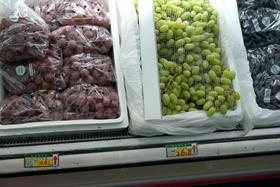
China’s imports of Chilean grapes are down dramatically in the season to date, but traders are anticipating a deluge of shipments in the coming weeks.
Supplies from Chile have been constrained by a number of factors so far this year. A delay to the harvest, which commenced around two and half weeks later than usual, is the main reason for the lack of arrivals so far, while drought-induced water shortages in some production regions in the north have also affected fruit volumes and sizing.
The port strikes in Chile, which brought exports to a standstill for almost two weeks between late March and early April, have since caused large stocks of grapes to build up on the wharves.
With a backlog of containers now leaving the Port of San Antonio and Chile's other key fresh fruit export terminals, Chinese importers are gearing up for an influx of fruit.
“The shortage of Chilean grapes so far is due to the delay in the season, but what happens from now on depends on the recovery from the port strike, and on what is happening in the export markets,” said Rod Hill of importer Golden Wing Mau.
“It's hard to tell how things will play out now but you’d have to assume we’re going to get a lot of fruit coming in the second half of May now the strike is over. There won’t be a lot of fruit in the market in early May, but post-strike we expect to see increased shipments from Chile to China.”
Strong demand from the US and Korea absorbed a large percentage of Chile’s earlier white and red seedless grapes, leaving very little for China, according to Hill, who noted that sendings of Chilean Red Globe to China were also down 40 per cent year-on-year as of early April.
However, significant volumes of grapes originally earmarked for shipment to Korea before the country’s duty hike kicks on 1 May have missed that deadline because of the port strikes. As such, exporters will have to find other markets for that fruit.
“They missed that window so where does it go?” said Hill. “Markets like China could bear the brunt of what becomes available.”
Australia finds more room in market
With the relative shortage of Chilean grapes in the season to date, market prices have been strong, according to importers, and Australian grapes in particular appear to have benefited.
“Australian Crimson has had a much better run this year; everyone is happier with the market in China,” said Hill.
Gary Esterman of Australian exporter Benny’s Exports concurred, while sounding a note of caution over Chilean arrivals.
“This season has seen many containers of grapes going directly to China,” he said. “Crimson Seedless has been selling well, and fruit with good bloom and colour that is well packed has been achieving good prices.
“With Chilean grapes not flooding the market, the Australian grapes have been moving well but it seems Chile is about the flood the market with many containers of grapes.”
Industry estimates indicate that around 130 containers had been shipped directly from Australia to China as of mid-April, an eight-fold increase on last year. Nevertheless, despite strong market prices in China, growers have faced significant difficulties getting to grips with the demands of the protocol and direct trade.
Sour note for South Africa
The South African grape industry, which is reflecting on a very tough season in China, also faced difficulties with meeting the demands of the quarantine protocol.
“South African grapes had a terrible season this year in China,” said Jason Bosch of Shanghai-based importer Origin Direct Asia.
“White seedless from South Africa is not a very popular variety in the market, but this year there was more volume loaded and almost all of it was sent directly to China and the longer transit time took its toll on the grapes, with most arrivals having dehydrated stems. With bigger volumes of more popular varieties such as Red Globe from Peru, the weak returns on white seedless were really compounded and the results were disastrous.”
Coloured varieties, such as Ralli and Starlight, and black seedless varieties fared little better for South Africa, bringing poor returns compared with previous years, added Bosch.
Hill was swift to note, however, that protocol problems for South Africa stemmed more from growers’ inexperience in shipping via that mode, rather than the protocol itself.
“What is a relatively easy protocol became very hard to work with because a lot of containers were rejected before shipment,” he said. “The growers are not used to working in this way, and there were quite a few instances of paperwork not filled in correctly, which led PPECB to reject fruit, or the cold treatment process going outside the protocol, and having to be restarted. All this contributed to significant delays in getting shipments off.”



